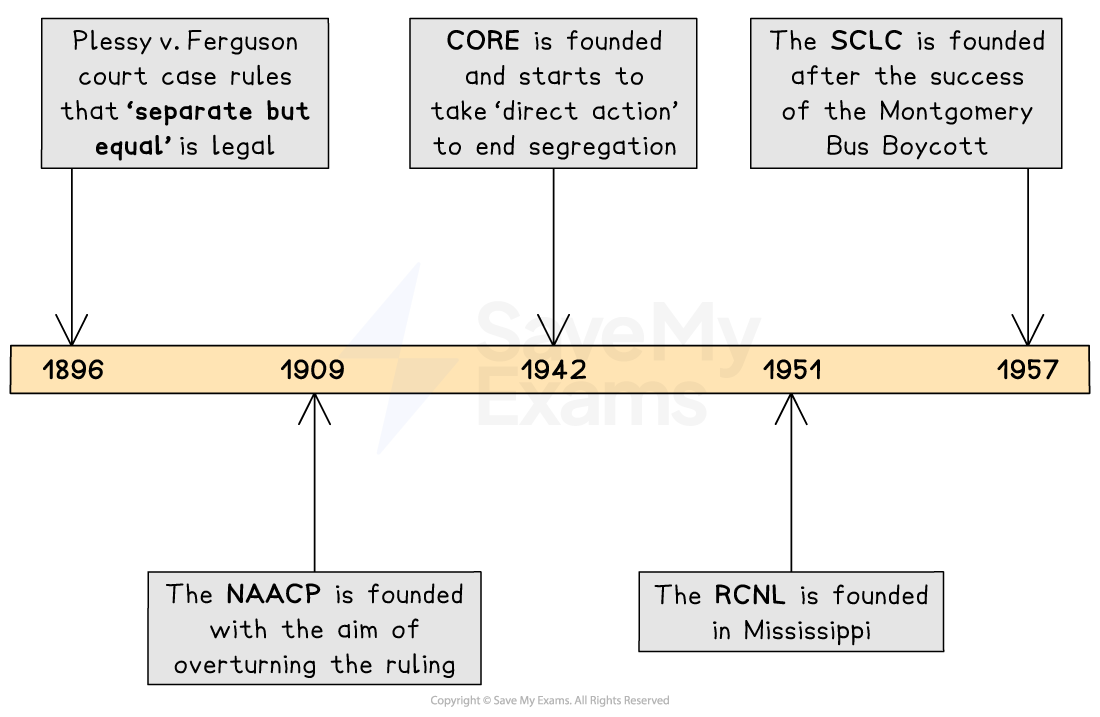Civil Rights Organisations (Edexcel GCSE History): Revision Note
Exam code: 1HI0
Timeline

Summary
From the start of the 20th Century, Black Americans began to organise and campaign against the segregation, prejudice and discrimination that they faced. This struggle became known as the Civil Rights Movement. The number of civil rights organisations grew as the years passed. Some organisations were national and some were regional. Some campaigned through the courts, others took direct action. The Black American church also started to play an increasingly important role in the struggle to end segregation.
The aims of civil rights organisations in 1950s America
Civil rights organisations campaigned for equal rights between White Americans and Black Americans
Their first aim was to end segregation in the South
Throughout the 1950s, they attempted to do this through non-violent means
The National Association for the Advancement of Colored People (NAACP)
The NAACP was founded in 1909
It sought to improve the lives of Black Americans by fighting and winning court cases
The focus of the NAACP was:
To overturn the ‘separate but equal’ court ruling of 1896
Prove that segregation was against the Constitution
The NAACP also helped defend Black Americans it believed had been unfairly accused and convicted of crimes
Its membership tended to be more mature and middle-class and included both Black and White Americans
Examiner Tips and Tricks
There are several civil rights organisations. It can be difficult to remember the names and key features of all of them, particularly when they are shortened to acronyms like NAACP and RCNL. Categorising them into national and regional organisations is a good way to help draw distinctions between them in your mind.
Congress of Racial Equality (CORE)
The CORE was founded in 1942
It sought to bring about change through non-violent direct action
The CORE challenged segregation by using techniques such as sit-ins
This involved occupying seats in ‘Whites only’ sections of restaurants and refusing to move
Its membership included both Black and White Americans but it attracted many younger people – especially students
The Regional Council of Negro Leadership (RCNL)
The RCNL was founded in 1951 and was based in Mississippi
It aimed to improve the lives of Black Americans by:
Encouraging voter registration
Campaigning against police brutality
Organising boycotts of petrol (gas) stations
Despite being a regional organisation, it became known nationally during the trial of Emmett Till’s murderers because it helped gather evidence to use in court
The organisation’s influence began to decline towards the end of the 1950s as the NAACP grew in importance
Church Organisations
The Church played a central role in the lives of many Black Americans in the South in the 1950s
Their Christian religion taught that every man was the son of God and therefore everybody, regardless of skin colour, was equal
Many activists and organisations emerged from Black American churches, including:
Southern Christian Leadership Conference (SCLC)
The SCLC was founded in 1957 after the Montgomery Bus Boycott to coordinate civil rights protests across the South
Reaction of White Americans to Church Organisations
Many White Americans welcomed the influence of the Black American churches in the debate over segregation
They appreciated its message of forgiveness and non-violence
Other White Americans resented the influence of the Black American Churches
They were concerned that the church could organise and mobilise large numbers of people
As a result, Black churches and worshippers became the target of violence from some White Americans

You've read 0 of your 5 free revision notes this week
Unlock more, it's free!
Did this page help you?